#uss ranger (cv-4)
Explore tagged Tumblr posts
Text

Le porte-avions USS Ranger (CV-4) – Base navale de Norfolk – Virginie – Etats-Unis – 7 juin 1934
©Naval History and Heritage Command - NH 93546
L’USS Ranger est le premier porte-avions de l'US Navy conçu et construit spécifiquement pour cette fonction. Il est le seul de sa classe.
#WWII#WW2#avant-guerre#pre war#marine américaine#us navy#marine militaire#military navy#marine de guerre#navy#porte-avions#aircraft carrier#uss ranger (cv-4)#uss ranger#cv-4#base navale de norfolk#naval station norfolk#norfolk#virginie#virginia#états-unis#usa#07/06/1934#06/1934#1934
15 notes
·
View notes
Text

4/9/1983..Aerial view of US Navy ships docked at the naval air station, North Island.They are (front to back): the battleship USS New Jersey (BB 62) and the aircraft carriers USS Kitty Hawk (CV 63) and USS Ranger (CV 61). USN Image/ PHC L. Foster
#naval warfare#us navy#navy ships#aircraft carrier#battleships#USS New Jersey (BB 62)#USS Kitty Hawk (CV 63)#USS Ranger (CV 61)
62 notes
·
View notes
Text
On 9 November, 1942, flying off the coast of Casablanca, French Morrocco in support of the Operation TORCH landings, the Piper Cub (under the name L-4 Grasshopper) made her official combat debut in the Second World War. This once-civilian plane had been bought by the U.S. Army to function as "air observation posts," flown by pilots in the U.S. Army Field Artillery, attached directly to battalions. Her concept, proven in training maneuvers, was as aerial reconnaissance; aerial photography; single-person transport; air ambulance; and in particular, reconnaissance and artillery observation. She would prove to be perfect for all of these roles. She would go on to have an incredible record during the Second World War, one of the best planes built for her particular role, with over six thousand of them bought by the U.S. Army. She was small, she could handle landing tiny fields, she was stealthy, she was dead simple to repair and reliable in the air.
But on that day? For that mission? There were only three Grasshoppers, and it was an absolute disaster.
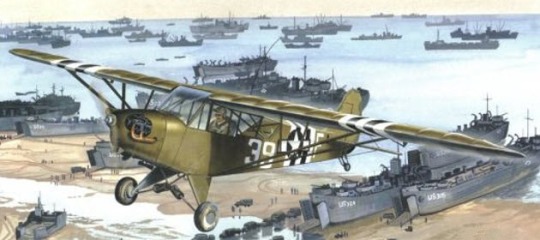
The three planes were attached to the 3rd Infantry Division. Their pilots were hurriedly brought to USS Ranger (CV-4), aboard which were three L-4 Grasshoppers in bad condition. All their efforts were getting the planes ready for flight. What the pilots did not know was that their commanders, from colonels to generals alike, did not prepare properly for their debut.
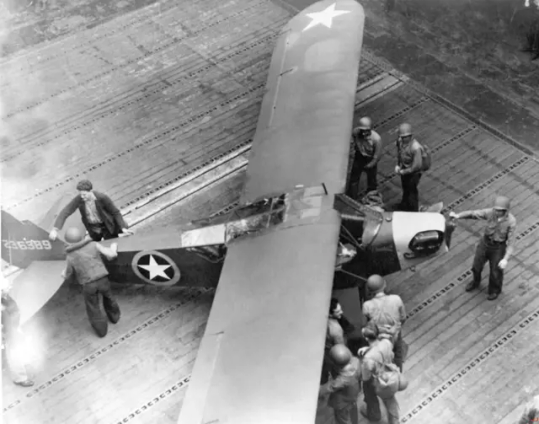
On 8 November American troops stormed ashore at Safi, Casablanca and Point Lyautey. The next day, Ranger turned into the wind, the pilots got aboard the planes. In the 35-knot wind the instant the ship's crew let go of their tails, the planes hopped off the deck and were in the air, sixty miles from shore.
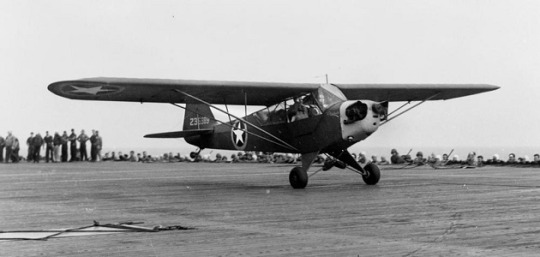
Three miles from the beach, the allied invasion force appeared. Transports, destroyers, the light cruiser USS Brooklyn. Aboard the Brooklyn alert officers and anti-air gun crews spotted the L-4 Grasshoppers.
There was nothing in the allied aviation recognition books that resembled the L-4 Grasshopper. None of the artillery pilots' superiors had properly distributed warnings that the Army had procured the civilian planes, and were using them for the first time.
The Brooklyn's anti-air weaponry opened up. 5" shells, 40mm bofors, 20mm Oerlikons reached out to lick at the Grasshoppers. In the first flak burst the quartet of little planes scattered, diving for the deck. Captain Ford Allcorn leveled off at twenty feet and started juking like mad, gamely going for the beach leading his flight. Every other ship, seeing the Brooklyn open up on the unfamiliar planes, joined in.
The artillery pilots had not the fuel to return to the ship, even if they'd been trained in carrier landings, which they weren't. Land was their only option for salvation. Shellfire blew out Allcorn's windshield, shot off one of the doors. As the Grasshoppers juked and weaved, bullets splashed into the water all around them. A hundred feet from shore, they levelled off and gunned their throttles to the maximum - 80 mph - for the safety of the shoreline.

At which point the pintle mount machineguns on tanks ashore opened fire on them. For nobody had told the Army troops of the 2nd Armored Division either about the Piper Cubs, and seeing the Navy so enthusiastically shooting at them, they joined in. .50-calibre bullets ripped into the Grasshoppers, betrayed by their own.
Captain Allcorn's engine cut out after several tanks' machineguns stitched bullets across the frame, and five bullets tore into his leg.
The wounded planes got to the shoreline. They flew over the armor, guns straining to shoot at them, desperately trying to get to the safety of the Fedala Racetrack, where they were supposed to go. Allcorn spotted a relatively flat area and pancaked in, crawling out of the mortally wounded flaming bird before the fuel exploded.
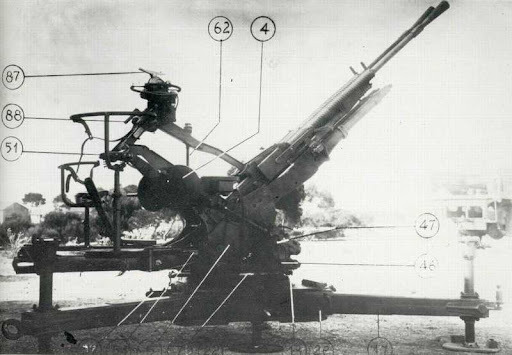
And then the Vichy French opened up.
Lieutenants Butler, Shell, and Captain Devol (one L-4 having carried two of them) were taken prisoner after crash landing behind Vichy French lines, but were released when the French in Casablanca surrendered two days later on 11 November.
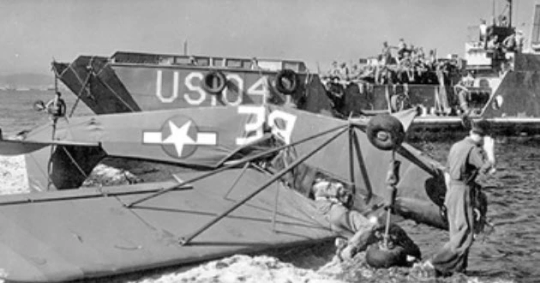
Amazingly, despite all this, nobody had been killed.
Captain Allcorn was the first Army aviator in the ETO to fly off a carrier, the first in combat, and the dubious distinction of the first to be shot down and the first to be wounded. Captain Allcorn, from his hospital bed back in the States, wrote a report about it all that even reached the Chief of Staff General Marshall's desk. He argued that this disastrous beginning was not the death knell of the Grasshopper. He concluded, perhaps rather dryly, that there was seemingly a failure to communicate between the Army and the Navy. His report helped the Piper Cub / L-4 Grasshopper survive the event, to go on to become one of the most produced aircraft of the war, and most widely used.
Even today, almost four thousand of the nearly twenty thousand Piper Cubs built are still in the FAA registry.
75 notes
·
View notes
Text

A pair of FR-1s prepare to take off from USS Ranger (CV-4) during carrier trials, May 1945
41 notes
·
View notes
Text
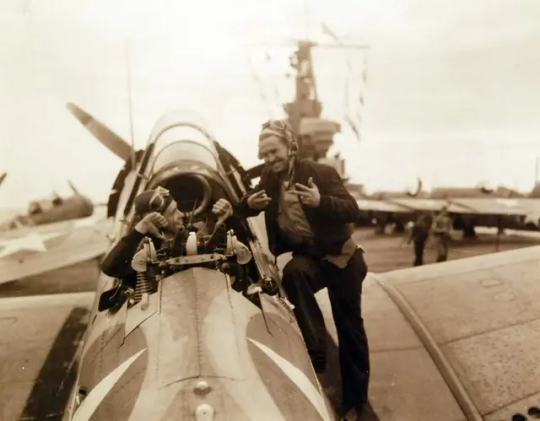
Operation Torch, November 1942. Planes of USS Ranger (CV-4) en-route to invade French North Africa, November 1942.
134 notes
·
View notes
Text






Tragedy at Sea
Drive onto the grounds of Mare Island's Touro University and head up the hill to what used to be the Bachelor Officers Quarters (BOQ) and you will find the administrative offices for the university. The building maintains its name from when it was a navy base, Wilderman Hall.
That name harkens back to a tragedy that occurred just after Thanksgiving in 1973. In 1971 Commander Alvin Wilderman, the captain of the USS Plunger (SSN-595) brought his submarine to Mare Island for a major overhaul. The arrival of the submarine was subject to much fanfare, for not only did such an overhaul represent a vast amount of work for the shipyard, but she was also constructed at Mare Island ten years before becoming the 500th ship built here.
During Plunger’s stay at Mare Island, Cdr. Wilderman proved himself to be a real gentleman and extremely smart individual well-liked by shipyard personnel. The award-winning Plunger was also singled out for more awards by the fleet including designation as ship-of-the-month and she was awarded the Battle “E” for efficiency award.
As the overhaul work and testing program work completed, the Plunger was scheduled for sea trials. Sea trials are the final step in returning a ship to the fleet. During sea trials every system is operationally tested in its natural environment as shipyard workers ride with the crew to assist. That testing program was to take place outside of the Golden Gate in an area off the Marin Headlands known famously as the “Potato Patch.” The area got its name from ships carrying potatoes to market that would overturn in rough conditions as swells broke over the shallow reefs guarding the entrance to the gate. The area was particularly hazardous during storms when wind whipped waves could turn the area into an aquatic hell.
As the week prior to Plunger’s Friday departure for sea trials progressed, a Pacific Storm was expected to hit at any time, although weather reports did not predict unusual intensity. High pressure over California held the storm at sea until Thursday when that high-pressure area began to drift to the east. As Plunger departed Mare Island Naval Shipyard rain was in the forecast, but there was still nothing particularly noteworthy in the predicted weather. As it turned out, a full gale was about to hit with winds so strong that the aircraft carrier USS Ranger (CV-61) that was scheduled to dock at Alameda Naval Air Station was held out in the bay to allow the storm to blow itself out. Meanwhile Plunger headed out the Golden Gate on the surface and into the teeth of the fast-moving storm. On the small bridge was Cdr. Wilderman, the Officer of the Deck (OOD) and a lookout. Plunger was encountering heavy weather with winds of more than 50 miles per hour and seas 12 feet and higher. The sail of this class of submarine was very small and low to the water. Recognizing the seriousness of the worsening situation, Cdr. Wilderman ordered the OOD and lookout below. He was now alone on the bridge.
The Plunger was entering the Potato Patch 6 miles out when at 4:17pm a large comber washed over the bridge and Cdr. Wilderman was swept into the chilly waters. As word of man overboard reached nearby shore facilities and ships, a massive search was undertaken. Back at Mare Island available ships were put to sea to assist the Coast Guard and other submarines including the USS Seawolf (SSN-575) that were operating in the area. Fog, gale force winds and driving rain all worked to hinder rescue operations. By the following day the storm had moved east, and calmer seas and sunny skies broke out, but it was too late. No sign of Cdr. Wilderman was ever found. Sadness broke over the shipyard as hundreds attended the well-liked skipper’s funeral services. For his selfless act ordering others to safety while he remained alone on the bridge, he was posthumously awarded the Meritorious Service Medal.
According to his wife Diane, Cdr. Wilderman considered Vallejo the best Navy town in the United States, and he spent some of the happiest days in the Navy at Mare Island. Cdr. Wilderman was not forgotten by his friends at Mare Island and ten years later, an effort culminated to name the BOQ located in one of the most peaceful and verdant areas of the shipyard after the fallen man. That recommendation was approved by the Chief of Naval Operations and the BOQ was so named in his honor. It is fitting that Touro University chose to retain the name Wilderman Hall and continue to honor Cdr. Wilderman who passed away at 36 years of age in service to his Nation. Cdr. Wilderman left behind his wife Diane and two sons.
Dennis Kelly
#mare island#naval history#san francisco bay#us navy#vallejo#san francisco#Cold War#Weather#Wilderman#Plunger#SSN-595#Potato Patch#Lost at Sea#Fast Attack
0 notes
Text
The USS Ranger (CV-4) was the US Navy's first purpose-built aircraft carrier, commissioned on June 4, 1934, at Newport News, Virginia. She served in the Atlantic and Pacific and took part in Neutrality Patrols in the Atlantic before the US entered World War II in December 1941. In early 1942, she transported aircraft to West African bases and took part in Operation Torch that November. The ship's design was modified to include an island, increasing its displacement to 14,500 tons. Ranger helped pioneer several design features that were incorporated in the later Yorktown-class carriers. The ship was sponsored by Lou Hoover during America's Prohibition period.

Officers and crewmen in formation during the commissioning ceremony of USS Ranger (CV-4), on June 4, 1934.

She was tied to pier at the Norfolk Naval Shipyard in Portsmouth, Virginia.

"Built by Newport News Shipbuilding and Drydock Company, USS Ranger was the first ship in the United States Navy to be designed specifically as an aircraft carrier. The ship spent most of World War II in the Atlantic. She was decommissioned in 1946."

Norfolk Public Library: smc_mss0000187_000611_013, smc_mss0000187_000611_007, smc_mss0000187_000611_008, smc_mss0000187_000611_012
30 notes
·
View notes
Text
USS Ranger CV-4 is launched

3 notes
·
View notes
Text

USN USS Ranger (CV-4) at sea in 1937.
1 note
·
View note
Text
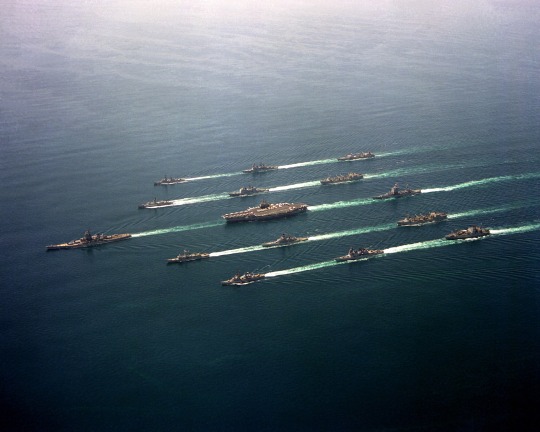
An aerial view of the U.S. Navy Battle Group Echo underway in formation in the northern Arabian Sea on 1 November 1987. The ships are, from the top, right to left,
Row 1:
USNS Hassayampa (T-AO-145),
USS Leftwich (DD-984),
USS Hoel (DDG-13);
Row 2:
fleet replenishment oiler USS Kansas City (AOR-3),
USS Bunker Hill (CG-52),
USS Robert E. Peary (FF-1073);
Row 3:
USS Long Beach (CGN-9),
USS Ranger (CV-61),
USS Missouri (BB-63);
Row 4:
USS Wichita (AOR-1),
USS Gridley (CG-21),
USS Curts (FFG-38);
Row 5
USS Shasta (AE-33),
USS John Young (DD-973) and
USS Buchanan (DDG-14) . USN Image PH3 Wimmer, U.S. Navy
78 notes
·
View notes
Photo

ヨークタウン (USS Yorktown, CV-5) はアメリカ海軍の航空母艦。
ヨークタウン級航空母艦のネームシップ。
その名を持つ艦としては三隻目。1942年、ミッドウェー海戦で沈没した。
1940年4月に行われた演習「Fleet Problem XXI 」での結論でハワイ水域の艦隊勢力を維持するため、ヨークタウンは翌年の春までアメリカ西海岸、ハワイ海域で活動した。
しかしながらドイツ海軍のUボートによる成功は、アメリカの海軍力変更を要求することとなった。大西洋艦隊強化のため、海軍はヨークタウンを含む主要戦力を移動させることとなる。
ヨークタウンは駆逐艦ウォリントン (USS Warrington, DD-383) 、ソマーズ (USS Somers, DD-381) およびジョーエット (USS Jouett, DD-396) と共に1941年4月20日に真珠湾を出港、パナマ運河を5月6日、7日に通過しバミューダに12日到着する。
このときからアメリカ海軍は戦争状態に突入し、ヨークタウンはニューファンドランドからバミューダへかけての範囲を4回偵察し、アメリカが中立でいる間に17,642マイルを航海した。
日本海軍による真珠湾攻撃で、アメリカ太平洋艦隊は大敗を喫する。
無傷の空母は戦略的な重要性を持つこととなる。1941年12月7日の時点で太平洋に配備されていた空母はエンタープライズ、レキシントン (USS Lexington, CV-2) 、サラトガ (USS Saratoga, CV-3) の三隻で、レンジャー (USS Ranger, CV-4) 、ワスプ (USS Wasp, CV-7) 、そして最近就役したホーネット (USS Hornet, CV-8) は大西洋にいた。
ヨークタウンは1941年12月16日にノーフォークを出港し太平洋に向かった。この間にヨークタウンは航行しながら20mm機銃を取り付けた。
12月12日にパナマ運河を抜け、1941年12月30日にサンディエゴに到着。そこで、新たに形成されたフランク・フレッチャー少将率いる第17任務部隊の旗艦となった。
サンディエゴでは補用機42機を搭載し、それによってヨークタウンの搭載機数は129機となった。
1942年に入り、日本軍は次の作戦としてポートモレスビー攻略を計画していたが、アメリカは暗号解読によりそれを察知した。
4月29日、ヨークタウンは次のような命令を受信した。
「五月一日より、珊瑚海で作戦行動すべし。
米豪交通線���確保するため、好機あらば敵艦隊および海上輸送、航空機を撃滅せよ」
5月5日、ヨークタウンはレキシントンと合流。またオーストラリアから出撃してきた第44任務部隊(クレース少将、重巡洋艦オーストラリア、軽巡洋艦ホバート)も合流した。これらの部隊は5月6日に統合され第17任務部隊となった。
ヨークタウンは油槽船ネオショーからの給油を開始したが、日本軍機に接触されたことから5月6日夕刻に補給を中断して艦隊は北西に向かった。
5月7日、ヨークタウンからドーントレス10機が索敵に発進し、そのうちの1機が空母2、重巡2発見を報告してきた。
これを受けてヨークタウンから42機(戦闘機8、急降下爆撃機24、雷撃機10)、レキシントンから50機(戦闘機10、急降下爆撃機28、雷撃機12)が発進した。
だが、敵空母発見は報告時のミスであり、実際には索敵機は空母は発見していなかった。
しかし、攻撃隊は日本軍のMO主隊(空母祥鳳、重巡洋艦4、駆逐艦1)を捕捉、攻撃した。攻撃隊は祥鳳の撃沈に成功し、結果的に日本軍のポートモレスビー攻略を断念させる。損害は戦闘機2機、急降下爆撃機3機であった。
一方この日、日本軍はネオショーを空母と誤認して空母翔鶴と瑞鶴から攻撃隊を発進させ、ネオショーを撃破し随行していた駆逐艦シムスを撃沈した。
5月8日、レキシントンから18機の索敵機が発進した。
索敵機は日本の機動部隊を発見し、ヨークタウンから39機(戦闘機6、急降下爆撃機24、雷撃機9)、レキシントンから43機(戦闘機9、急降下爆撃機22、雷撃機12)が発進した。
攻撃隊ではまずヨークタウン第5哨戒機中隊(急降下爆撃機7)が翔鶴を攻撃したが命中弾なし。
続いてヨークタウン第5爆撃機中隊(急降下爆撃機17)が攻撃し、翔鶴に1000ポンド爆弾2発を命中させた。
第5爆撃機中隊の攻撃後、ヨークタウン第5雷撃機中隊(雷撃機9)が翔鶴を攻撃したが、命中魚雷は無かった。
ヨークタウン攻撃隊の損害は喪失、急降下爆撃機3、大破、急降下爆撃機9、雷撃機1、小破、急降下爆撃機6、雷撃機2であった。
翔鶴はこの後のレキシントン隊の攻撃でさらに100ポンド爆弾1発が命中している。
アメリカ軍の攻撃隊が日本の空母を攻撃しているころ、アメリカの空母も空襲を受けていた。
ヨークタウンはまず雷撃8~9本を受けたがこれは回避した。
次いで江間保大尉率いる瑞鶴艦爆隊の攻撃を受け250キロ爆弾1発が艦橋後方、2番エレベーター前に命中し、また3発の至近弾によって燃料漏れが生じた。
命中した爆弾は飛行甲板、第5爆撃隊の待機室、海兵隊居住区、倉庫の順に貫通し、飛行機用補用品倉庫の装甲甲板で炸裂した。
この攻撃でヨークタウンは第7, 8,9ボイラー室からの煙路が破壊され、速力が24ノットまで低下した。
この攻撃ではレキシントンも損傷し、いったんは復旧したものの爆発を起こして炎上し、自沈処分された。
珊瑚海海戦終了後、ヨークタウンは5月10日にトンガタプ島に投錨。
この���のヨークタウンは燃料事情が深刻となっており、既に重油は無くなり、ディーゼル油を炊いてかろうじてトンガにたどり着いていた。
ヨークタウンはすぐさま補給を行おうとしたものの、そこで唯一補給可能であったものはイギリス船搭載のもののみであり、その質は悪く硫黄が浮いていたという。燃料補給とともに応急修理もなされた。
5月24日、フレッチャー少将は速やかに帰投せよとの命令を受け、同日ヨークタウンはトンガタプ島を離れ、5月27日に真珠湾に到着した。
真珠湾に帰港すると、太平洋艦隊司令長官チェスター・W・ニミッツ大将が直接損傷状況検分を行い、応急措置を施せば戦列復帰は可能と判断、3日で修理を行うよう命令した。
修理は24時間体勢の突貫工事で、作業効率を優先し民間人である修理工に兵隊を指揮監督させる方式で行われた。
修理法は破損箇所に鋼板をツギハギで溶接、換気不十分で艦内温度が48.9℃の蒸し風呂状態といったいささか乱暴なものであったが、オアフ島の一部を停電にして海軍工廠に電力を優先に供給するよう調整するなど全面バックアップが取られ、2日後の29日11時には穴は完全に塞ぎ終わりドックの外へ出す事が出来るまでに回復された。
ただ、ヨークタウン乗組員の回想では修理はいい加減な間に合わせであり、実際、艦各所の隔壁が破壊されていたりずれていたために水密性も大きく悪化しており、ただでさえ低い水雷防御力が更に低下していた。
ミッドウェー海戦においてヨークタウンは、当初フレッチャー少将の指示により後方で艦隊直掩と索敵を担当することとなっていた。
しかしレイモンド・A・スプルーアンス少将率いる第16任務部隊が発見した日本空母艦隊へ攻撃隊を発艦させた際、フレッチャー少将は新たな敵艦隊が居なかったことからヨークタウンも攻撃に加わることを決めた。
攻撃に向かう際、レスリー少佐機含む爆撃機隊4機が整備時の配線ミスで爆弾を誤投棄してしまうアクシデントがあったが、レスリー隊はそのまま日本艦隊へと向かった。
ヨークタウン発艦時にペダーソン飛行長が行った航行指示が功を奏し、ヨークタウン攻撃隊は全部隊がまとまって日本艦隊に辿り着き、攻撃を行うことができた。
42機にも及ぶ零戦の直援隊による攻撃を受け、雷撃機隊はマッセイ少佐含む10機が撃墜される大損害をうけたものの、サッチ少佐率いる戦闘機隊は後にサッチ・ウィーブと呼ばれる対零戦用編隊空戦術を行い1機被撃墜に対して5機撃墜という戦��を上げた。
そしてレスリー少佐率いる爆撃機隊は、攻撃を受けて緊急支援要請を出したマッセイ少佐らの攻撃機を援護するため前方に見える空母蒼龍を攻撃。爆弾3発を命中させ、後に沈没させる戦果を上げた。
なおこの時レスリー少佐は前述のアクシデントにより爆弾を誤投棄してしまっていたが、僚機の援護のために部隊の先頭に立ち、機銃掃射をもって突撃したという。
この時同時に攻撃を行ったエンタープライズ爆撃機隊の攻撃により、空母赤城、加賀も後に沈没する事となった。
だが、この後ヨークタウンは残る飛龍の反撃を一身に受けた。
飛龍攻撃隊の接近に伴いヨークタウンでは対空戦闘準備が行われていたが、この時ヨークタウンは全力出力で284RPM、30.5ノットを発揮していたという。
まず第1次攻撃隊として小林道雄大尉率いる18機の九九式艦上爆撃機の攻撃が行われ、直掩機の迎撃により10機が撃墜され、対空砲火の迎撃により2機が投弾前に撃墜された。
ヨークタウンでは5インチ砲はじめ全ての火力を用いて日本軍機を迎撃したが、残る6機の爆撃を受け3発が直撃した。
これによりヨークタウンは炎上し、第1ボイラー室を除いて全ての動力を喪失、航行不能に陥ったが、迅速な応急修理もあって被弾から約25分後には艦載機の発着艦が可能となり、更に1時間後の13時50分には第4から第6ボイラーの復旧に成功した。
しかし、被弾による影響によりレーダーと無線は使用不可能になっており、フレッチャー少将は12時34分に旗艦を重巡洋艦アストリアへ変更すること決意し、移乗した。
応急修理完了から約40分後の、ヨークタウンは飛龍からの第2次攻撃隊として6機の零戦に護衛された友永丈市大尉率いる九七式艦上攻撃機10機の雷撃を受ける。
ヨークタウンは最大速力で20.5ノットしか出なかったが、友永大尉ら第一中隊5機中4機が放った魚雷をすべて回避した。
だが次席指揮官の橋本敏男大尉率いる第二中隊率いる5機中4機が放った魚雷の内2本が左舷を直撃、再びヨークタウンは航行不能に陥った。
この際、橋本大尉は友永大尉機がヨークタウン艦橋に体当たりしたと証言しているが、アメリカ側では被弾し海面に突入したと記録されている。
この被雷により全てのボイラーが停止、短時間のうちに26度まで傾斜し、転覆の危険もあった。
バックマスター艦長はヨークタウンが助からないと考え、14時58分に総員退艦を下した。
ヨークタウンは日本軍による鹵獲を警戒して雷撃処分のための駆逐艦ヒューズと共に取り残された。
だがバックマスター艦長はまだヨークタウンを諦めておらず、重巡アストリアに救助隊を集結させていた。
ヨークタウンは修理不足により水密性が悪化した状況でありながら沈没せず、6日午前4時40分、総員退艦から38時間後にハムマン (USS Hammann, DD-412)がヨークタウンに横付けした。
バックマスター艦長以下救助隊は駆逐艦ハムマン(USS Hammann, DD-412) からヨークタウンに移乗し、左舷5インチ砲架の切断投棄、艦載機の残骸の投棄等の作業を開始した。
だが日本海軍もまだ行動しており、連絡を受けて遅れて戦場に入った田辺弥八少佐指揮下の日本潜水艦伊一六八によってヨークタウンは現地時間6月7日5時半に発見された。
ヨークタウンは3ノットで曳航されながら駆逐艦ハムマンが横付けして復旧作業の最中であり、傾斜が22度まで回復していた。
厳重な警戒態勢であったが、伊一六八はその場で360度旋回をしたり、ヨークタウンや駆逐艦の真下を通過するなどして距離を計り、発見から8時間後の13時に4本の八九式魚雷が発射された。
これを発見したハムマンは即座に機銃で魚雷の迎撃を図り、ヨークタウンからの離脱を行いつつ、爆雷を起爆状態にセットし、対潜戦闘に移ろうとした。
だが、ヨークタウンには2本の魚雷が右舷に命中。ハムマンもヨークタウンから離脱するだけの時間があるはずもなく魚雷1本が命中、ハムマンは轟沈した。
魚雷の被害に加えハムマン轟沈時のボイラー爆発と爆雷の誘爆の衝撃がヨークタウンを襲い、右舷喫水線下の損害が更に拡大した。
皮肉にも右舷への浸水で傾斜角が17度まで回復したが、既に浸水量はヨークタウンの浮力を超え、船体は沈みつつあった。
バックマスター艦長はそれでもなおヨークタウンを救おうと夜通しヨークタウンを修理する志願者を募ったが、ヨークタウンの状態は悪化し復旧作業は断念された。
ヨークタウンは2度目の総員退艦が行われた。
ヨークタウンを討った事で、護衛の駆逐艦からの反撃は熾烈を極め、伊一六八も大きな損傷を受けたが現場からの退避に成功した。
ヨークタウンはさらなる大浸水にも関わらず、翌日5時頃まで艦を保ち続けたが、ついに左舷から転覆し沈没した。
その最期は決して美しいものではなく、艦載機の残骸の立てる耳障りな轟音が鳴り響く中、魚雷とハムマンの爆雷で破られた醜い船腹を晒して沈没していったと云う。
ヨークタウンは沈没に長時間を要したため戦死者数は58名と極めて少数に留まった。
ヨークタウンは第二次世界大戦での戦功により3つの従軍星章を受章した。
2つは日本軍の拡張を止めるのに大きな役割を果たしたことに対して与えられ、もう1つは珊瑚海海戦とミッドウェー海戦での功績に対して与えられた。
ヨークタウンに止めを刺した伊一六八はその後の海戦によって撃沈されたが、田辺艦長は他の潜水艦に転勤となっていたため終戦まで生き延びた。
戦後、田辺艦長はGHQから伊一六八のヨークタウンへの攻撃について執拗な調査があり、その慎重かつ大胆な攻撃方法に調査を担当した米兵も驚いたとされ��いる。
1998年5月19日に、海底に眠るヨークタウンの船体が確認、撮影された。
船尾から海底に衝突したために、最後部は変形しているが、舷側部の魚雷命中孔以外は大規模な破損は見つかっていないとされている。
4 notes
·
View notes
Text

A 1.1" anti-aircraft gun on alert aboard USS Ranger (CV-4) during the North African landings, November 1942.
24 notes
·
View notes
Text
Ronnie Bell Following
Vought SB2U Vindicator.
Vought SB2U Vindicator) from the aircraft carrier Ranger (USS Ranger CV-4) antisubmarine patrols over the convoy (WS-12) vessels on the way to Cape Town.
From left to right, front row: the heavy (the USS Vincennes (CA-44), the ship West Point "(the USS West Point (AP-23), (USS Mount Vernon (AP-22) (USS Wakefield (AP-21) centre row is the heavy cruiser USS Quincy (CA-39). in the second row of the" transports USS Leonard Wood (AP-25) and (USS Joseph t. Dickman (AP-26).
27th November 1941.
Via Flickr
9 notes
·
View notes
Text
Testing the machine guns of Grumman F4F-4 Wildcat fighters aboard the aircraft carrier USS Ranger (CV-4) while en route from the U.S. to North African waters in November, 1942.
Testing the machine guns of Grumman F4F-4 Wildcat fighters aboard the aircraft carrier USS Ranger (CV-4) while en route from the U.S. to North African waters in November, 1942.

View On WordPress
0 notes
Text


USS RANGER (CV-4) at the Norfolk Naval base, Virginia.
Photographed from a USAAC plane on June 7, 1934.
U.S. Naval History and Heritage Command: NH 93545, NH 93546
#USS Ranger (CV-4)#USS Ranger#Aircraft Carrier#June#1934#interwar period#norfolk navy yard#Norfolk#Virginia#united states navy#us navy#navy#usn#u.s. navy#my post
59 notes
·
View notes
Text


Task Force Zulu:
4 carriers all from 4 different classes, starting upper left and rotating clockwise:
• USS Midway (CV-41) Midway-class
• USS Theodore Roosevelt (CVN-71) Nimitz-class
• USS America (CV-66) Kitty Hawk-class
• USS Ranger (CV-61) Forrestal-class
All together more than a kilometer of ship and well over 200 aircraft carried!
6 notes
·
View notes
